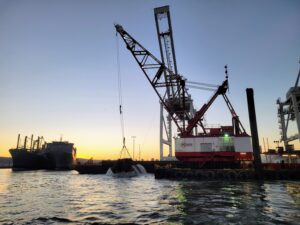The El Niño of 2015–16 was not the drought panacea Californians might have hoped for, but it was still one of the strongest El Niños on record, and a new study shows how it dramatically reshaped the state’s coastline. A team led by U.S. Geological Survey coastal geologist Patrick Barnard determined that last winter generated either the most powerful, or second most powerful, waves ever recorded in the Eastern North Pacific, and those waves, combined with elevated sea level caused by El Niño’s warm water, ripped tons of sand and sediment off California beaches and out to sea.
After the El Niño had ended, Barnard’s team surveyed 29 beaches along 1,200 miles of the West Coast and found that shorelines had retreated an average of 115 feet—76 percent more than a normal year and 27 percent more than in the previous record year. They reported their findings in February 2017 in the journal Nature Communications.
Of the 18 sections of shoreline Barnard and his team surveyed in California, there are now 11 farther inland than ever before recorded. From Capitola to Moss Landing, the team measured an average of 150 feet of shoreline retreat; at Ocean Beach in San Francisco, the Pacific has closed in on the Great Highway by as much as 180 feet. The stretch from Ocean Beach to Pacifica is the fastest eroding coastline in the state, Barnard says, and this lost ground is unlikely to be made up soon.
A combination of dam construction and drought has reduced the amount of sediment delivered to beaches by rivers and streams, which typically replenish what is lost to storms each winter. The effect is especially pronounced in the Delta, where damming, aggregate mining, sand mining, and dredging have reduced the amount of sediment carried into the Bay from 4 million to 1 million cubic meters annually. Winter rains in 2016-17 washed a substantial quantity of sediment to the coast, but Barnard says the sediment will mainly build up near river mouths and will take years to evenly distribute to farther off beaches. It took about 10 years for beaches to recover after the similarly powerful waves of the 1997-1998 El Niño, he says.
With less beach to absorb the force of violent waves, seaside infrastructure is more vulnerable to damage from future extreme events, Barnard says. Some climate models predict that severe El Niños could become more common, and Barnard recommends using the extreme conditions of last winter to identify problem areas in coastal infrastructure and address them now.
“This is not our grandchildren’s problem,” Barnard says. “We are getting these climate-change influenced events now and we should expect more of them in the future.”





